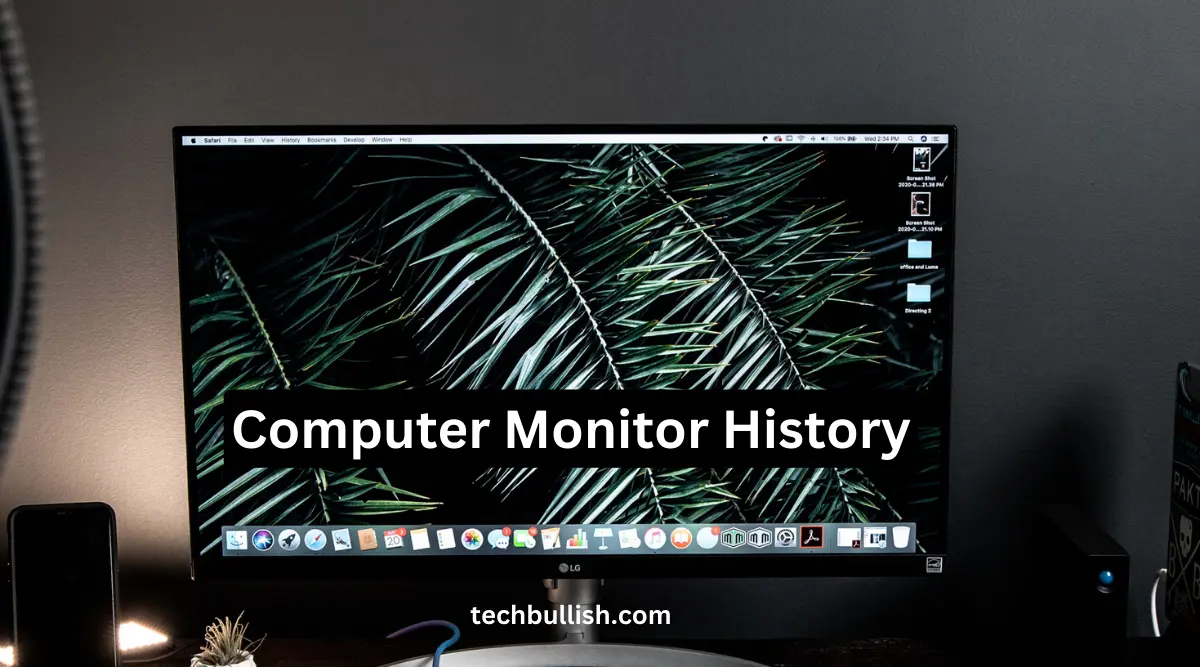The history of computer Monitors is amazing and they have come a long way since their inception.
If you look through their timeline, initially, they were bulky, low-resolution devices that displayed only basic text and graphics. However, over the years, they have evolved to become sleek, high-definition displays capable of displaying stunning images and videos.
Modern monitors come in a range of sizes, resolutions, and display technologies, such as LCD, LED, and OLED, to name a few. These advancements have greatly improved the overall user experience and made computing more visually immersive and enjoyable.
In this post, you will learn in detail about the Computer Monitor’s History.
So, Let’s get started!
History of Computer Monitors

The seedling of CRT monitor technology was planted in 1964. Although it was not only a computer monitor but a CRT display built by the Uniscope 300 machine. In 1965, Touch screen technology was invented by E.A. Johnson.
Finally, with the emergence of the first computer monitor designed with CRT technology and monochrome display, the Xerox Alto computer was launched in 1973.
Even though George Samuel Hurst developed the first resistive touchscreen display in 1975, this model was not in vogue until 1982. Aware of the growing fascination for computer monitors, Apple I took no time to create a built-in video output port in 1976 to credit computers with video screens.
Sol-20 computers were another patron working simultaneously in this field at the same time. 1977 saw the emergence of the first LED display technology developed by James P.Mitchell.
This was not a consumer-friendly product though and saw its popularity after decades. Another upgrade this year was with the color display on the CRT monitor by Apple II.
However, the credit for the first VGA monitors goes to IBM for releasing IBM8513 in 1987. Soon VESA 1989 officially designed the SVGA standard for computer display.
The technological advancement of the late 1980s cannot be neglected since it was this period that made CRT monitors capable of handling a 1024×768 resolution display.
In the 1990s Eizo Nanao Technologies manufactured the first LCD monitor, the Eizo L66. The pattern was followed by tech giants like Apple, IBM, and ViewSonic with rapid innovations.
Without losing any chance Apple banged the first place by manufacturing a user-friendly color LCD monitor for desktop computers, “The Apple Studio Display” This took over the market from CRT monitors making LCDs extremely popular in consumer markets by 2007.
Somewhere in between this tug of technological excellence, Jeff Han introduced the first inter-free touch-based computer monitor in 2006 at TED. By late 2009, the first LED monitors for the “MultiSync EA222WME” were manufactured by NEC.
Meanwhile, AMD and Intel were in the race with their interest in supporting VGA yet again in 2010.
With the growing demand for technical elegance, Touch screen LCD monitors took the prime zone in the consumer market. Due to their budget-friendly aspects, this product claimed remarkable popularity.
Early Screens
The early monitor screens were illuminated with rows of blinking indicators lights flashing on and off with the instructed commands or while accessing memory locations. Hollerith punched cards were used for input and output as well.
Programs were typed on typewriters-like machines to encode instructions that were punched into the paper card. Long rolls of paper tape were also used as an alternative for punched cards.
Experts were needed to decode these punch cards, dropping them in computers that read and run the programs. Likewise, operations ran the paper tape through a device with finally electric typewriters typing the computer output on the paper rolls making it readable. ENIAC was one such type of early electronic computer.
The arrival of Plasma Screens
The 1960s saw the emergence of Plasma screens. It was a display technology designed with a charged gas trapped between two glass plates.
A glowing feature emerged whenever a change was applied across the sheets in specific zones. PLATO TV terminal is known to be among the earliest ones to use a plasma display for their computers.
However, later IBM and GriD innovated the concept with thin, lightweight displays in portable computers. Sadly, this technology did not meet much popularity with PCs although it regained publicity with TVs.
Arrival Of CRT
CRT or the cathode-ray tubes were a form of memory and not a display in early computers. Recognizing the efficiency of CRTs, designers used them to show the contents of CRT-based memory.
Using a radar and oscilloscope, CRTs were used for initial graphical displays like in the SAGE system and the PDP-1.
These were not very popular anyways.
The arrival of Flat Screen Monitors with LCD
The liquid crystal display of the LCDs was another computer display technology that had seen its popularity in calculators and wristwatches primitively. Portable computers took all advantage of this flat screen, perfectly utilizing its features for computer displays.
LCDs were energy efficient and lightweight. Although they required separate backlight due to their monochrome and low contrast.
Early LCDs required direct illuminations to read them. LCDs innovated with laptop computers gaining more contrast, optimum viewing angles, and progressing color quality. LCDs used less desk space saving electricity with no heat emulsion.
With Apple, IBM, and ViewSonic introducing color LCDs competition for CRT monitors got tougher.
Modern Monitors with Latest Display Technologies
Widescreen LCD monitors are highly considered in the PC industry. Cost-effective and budget-friendly are two vital aspects making LCDs a hot business in the consumer market. Their innovative strategies led to the creation of 3D support through special glasses with ultrahigh refresh rates.
Leaving no room for special activation, computer monitors and TVs are meeting their elegance with LCD flat screens with TV sets getting digital making LCDs popular for obvious reasons.
New technologies added consumer-friendly features to flat panel displays like the glossy screen which replaces the anti-glare matte finish with a glossy one, enhancing color saturation and sharpness.
Curved designs in these flat panels reduce geometric distortion for a close viewing range. They project the perception of depth with special 3D glass and polarizers.
Diverse features added to these latest displays are anti-glare and anti-reflection screens, a directional screen for narrow-angle visuals, integrated professional accessories like integrated screen calibration tools and signal transmitters, a Tablet screen, local dimming backlight and backlight brightness or color uniformity compensation.
These latest display technologies come with a variety of mounting methods too.
Who invented the computer monitor?
“Karl Ferdinand Braun” invented the first computer monitor in 1897. He was a German Physicist born on 6th June 1850. Other than the inventor of the first computer monitor, Karl was a Nobel Laureate in Physics. His contribution in the development of Majorly Radio and Television technology is significant.
The CRT is also called the “Braun Tube” owing to Karl’s inspiration. This primary computer monitor was made with a fluorescent beam with the cathode beam tube and a cathode beam oscilloscope.
The CRT transmitted light when electrons strike them. The cathode beam tube is a vacuum tube covered with phosphors at one end. They show lackluster vector designs instead of reviewing text prior to displaying illustrations and texts. They showed texts and designs used to handle information.
The CRT produces an image by projecting a series of electrons onto a screen. These CRT displays were widely used before the emergence of LCD. Although CRTs are cheaper and they still provide rich color in a fuller variety. However, they are power-hungry and generate heat.
FAQs
What is Monitor?
When was the computer monitor invented?
What were computer monitors called in the ’80s?
What year did flat-screen computer monitors come out?

I’m Anirban Saha, Founder & Editor of TechBullish. With a B.Tech in Electronics and Communication Engineering, and 5+ years of experience as a software developer, I have expertise in electronics, software development, gadgets, and computer peripherals. I love sharing my knowledge through informational articles, how-to guides, and troubleshooting tips for Peripherals, Smart TVs, Streaming Solutions, and more here. Check Anirban’s Crunchbase Profile here.
